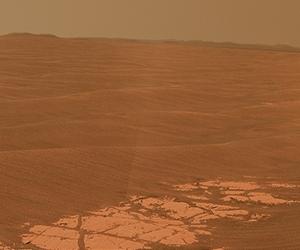 |
Washington DC (SPX) Jul 05, 2010
Complex interactions between Saturn and its satellites have led scientists using NASA's Cassini spacecraft to a comprehensive model that could explain how oxygen may end up on the surface of Saturn's icy moon Titan. The presence of these oxygen atoms could potentially provide the basis for pre-biological chemistry.
The interactions are captured in two papers, one led by John Cooper and another led by Edward Sittler, published in the journal Planetary and Space Science in late 2009. Cooper and Sittler are Cassini plasma spectrometer team scientists at NASA's Goddard Space Flight Center in Greenbelt, Md.
"Titan and Enceladus, another icy moon of Saturn, are chemically connected by the flow of material through the Saturn system," Cooper said.
In one paper, Cooper and colleagues provide an explanation for forces that could generate the Enceladus geysers that spew water vapor into space. In the other, published in the same issue, Sittler and colleagues describe a unique new process in which oxygen that circulates in the upper atmosphere of Titan can be carried all the way to the surface without further chemical contamination by being encased in carbon cages called fullerenes.
The work draws upon previous work by Sittler and others that model the dynamics of how particles, including water molecules, travel from Enceladus to Titan. At Enceladus the flow process begins with what they call the "Old Faithful" model, after the Old Faithful geyser in Yellowstone National Park.
In this model, gas pressure slowly builds up inside Enceladus, then gets released occasionally in geyser-like eruptions.
Unlike terrestrial geysers, or even geyser-like forces on Jupiter's moon Io, the model proposed by Cooper shows that charged particle radiation raining down from Saturn's magnetosphere can create the forces from below the surface that are required to eject gaseous jets.
Energetic particles raining down from Saturn's magnetosphere - at Enceladus, mostly electrons from Saturn's radiation belts - can break up molecules within the surface.
This process is called radiolysis. Like a process called photolysis, in which sunlight can break apart molecules in the atmosphere, energetic radiation from charged particles that hit an icy surface, like that of Enceladus, can cause damage to molecules within the ice.
These damaged molecules can get buried deeper and deeper under the surface by the perpetual churning forces that can repave the icy surface. Meteorites constantly crashing into the surface and splashing out material might also be burying the molecules.
www.spacedaily.com






